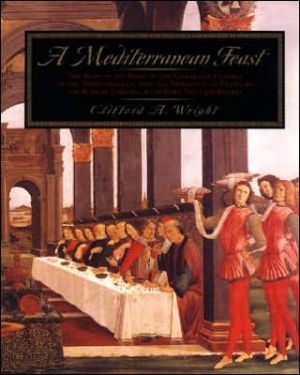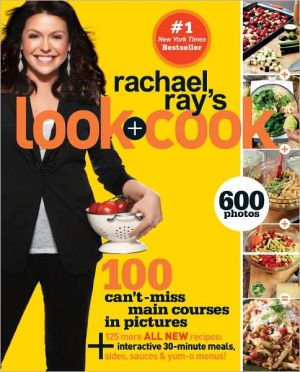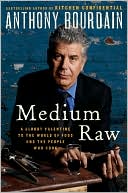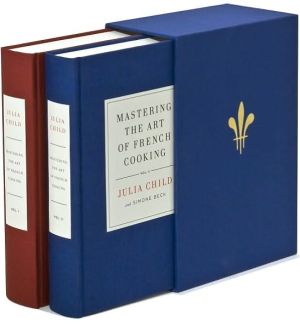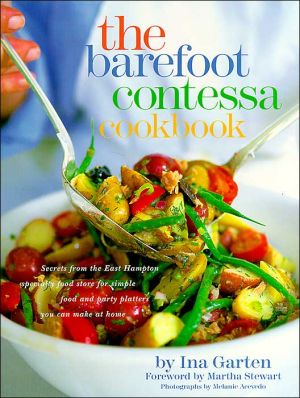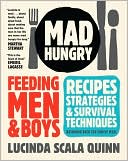Mediterranean Feast: The Story Of The Birth Of The Celebrated Cuisines Of The Mediterranean, From The Merchants Of Venice To The Barbary Corsairs, With More Than 500 Recip
A groundbreaking culinary work of extraordinary depth and scope that spans more than one thousand years of history, A Mediterranean Feast tells the sweeping story of the birth of the venerated and diverse cuisines of the Mediterranean. Author Clifford A. Wright weaves together historical and culinary strands from Moorish Spain to North Africa, from coastal France to the Balearic Islands, from Sicily and the kingdoms of Italy to Greece, the Balkan coast, Turkey, and the Near East.\ The...
Search in google:
The Story of the Birth of the Celebrated Cuisines of the Mediterranean, from the Merchants of Venice to the Barbary Corsairs, with More than 500 Recipes The story of the birth and evolution of the cuisines of the Mediterranean Basin is the story of wars and plagues, political intrigue and pirates, the Silk Road and the New World, the rise of capitalism and city-states, the Crusades and the Spanish Inquisition, and the obsession with spice. A groundbreaking cookbook based on original, primary research in eight languages, A Mediterranean Feast weaves together historical and culinary strands from Moorish Spain to North Africa, from Sicily and the kingdoms of Italy to Greece, the coasts of the Balkans, Turkey, and the Near East. Author Clifford Wright shows how the cuisines of the Mediterranean have been indelibly stamped with the uncompromising geography and climate of the area and a past marked with both unstinting poverty and wildly outrageous wealth. The 500 recipes included, adapted for today's kitchen, show the range of culinary ingenuity and indulgence, from the peasant kitchen to the merchant pantry. They also show the migration of local culinary predilections, tastes for foods and methods of preparation carried from home to new lands by seafarers, soldiers, merchants, and religious pilgrims. Historical illustrations and maps of the Mediterranean, from the past to the present, also highlight this epic book. An astonishing accomplishment of culinary and historical research and detective work, A Mediterranean Feast is required-and intriguing-reading for any cook, armchair or otherwise. Library Journal Wright's first cookbook was Cucina Paradiso, a fascinating exploration of the Arab influences on Sicilian cuisine. Since then he has published several collections of quick and easy Italian food, but now he has returned to the culinary history and anthropology that is obviously his true love. Originally a Middle Eastern scholar, Wright has devoted an enormous amount of research to answering the question, "What is Mediterranean cuisine?" He debunks the common view of the region as one of historical culinary bounty, and he traces the influences and interconnections among the food and cooking of the diverse cultures that ring the Mediterranean Sea. Along the way, he considers such topics as "The History of the Fork" and provides dozens of what he refers to as "heirloom recipes"--they have a history to them, but they are contemporary rather than re-creations of medieval or other early dishes. A unique work, this is recommended for history as well as cookery collections. Copyright 1999 Cahners Business Information.
Dedication\ For\ THE PHILOSOPHERS\ and\ THE COOKS\ without whom would be served forth\ half-baked ideas and thoughtless food\ \ \ An Algebra of Mediterranean Gastronomy\ In the ninth century, the word algebra was used for the first time in the title of the famous work by the Muslim mathematician Muhammad ibn Musa al-Khwarazmi, Kitab al-mukhtasar fihisab al-jabrwa'l-muqabalah, which can be roughly translated as "The hook of summary concerning the process of calculating compulsion and equation," with the word al-jabr giving us the word algebra. Al-jabr in the title means restoration and amplification or balancing something incomplete. Al-Khwarazmi did not use any symbolic notation in his book, for his argument was rhetorical. His hook was first translated into Latin by Robert of Chester in 1145, and al-Khwarazmi himself gave his name to our English word algorithm.\ Why does a cookbook begin with the etymology of algebra? The reason I've chosen this approach is that there really is no such thing as "Mediterraneancuisine." At the same time, we seem to know what we mean when we use the expression. This paradoxical phenomenon needs to be explained and this book is my attempt to explain it: to inquire into the value of an unknown, call it x. I'm using algebra as a paradigm for determining the value of x, x being the contemporary Mediterranean cuisines that developed from the centuries of struggle that we will encounter in the chapters ahead. I suspect "Mediterranean cuisine" is an invention of Anglo-Saxons, for I have never heard, until the past few years, any native of the Mediterranean (who lives in the Mediterranean) refer to such a thing. But after Elizabeth David published her famous A Book of Mediterranean Food in 1950, the expression "Mediterranean cuisine" became common, even though we weren't quite certain what was being referred to. The sense in which I use the word algebra is a desire for certainty, for a complete picture. I hope to expose the foundation of Mediterranean gastronomy, which we will see begins with a consideration of the historical situation in which it arose, as well as the climate, the harvest, the search for food. I will show in Part I that understanding contemporary Mediterranean food is rooted in the history of the Mediterranean peoples and their struggle against poverty and famine. The story of today's celebrated Mediterranean cuisines begins with the fall of the Roman Empire and the rise of Islamic civilization. This is somewhat at variance with the traditional approach, which begins with the ancient Egyptians or the classical Greeks. The story I tell unfolds with the emergence of feudalism and the transition to capitalism. It is a story affected by agricultural revolutions, the plague, innovations in technology, and the Age of Exploration. Once the historical context is set, we can explore where our Western cuisine comes from and how it developed. We will consider how harvests were more of sorrow and food more of dreams in a Mediterranean world where the climate was cruel, scarcity the norm, and vagrants, bandits, the religiously pious, and even the rich struggled for their nourishment. The last chapter of Part I, called "Feast, Anti-Feast," will look at how food determined all. We will look at a sampling of Mediterranean cultures in a variety of historical eras to see how the victory over hopelessness transformed Mediterranean foods from subsistence to cuisine.\ The Historical Foundation of Mediterranean Gastronomy\ Cabbage was one of the most common foods on the Mediterranean table for more than a millennium. In the simple cabbage we find a paradigm for the evolution of Mediterranean cuisine. The horticultural progress of the cabbage from a simple leafy vegetable to the compact tight-headed one of today, from cabbage cooked in water to the following contemporary minestrone di cavolo recipe from Pisa in Tuscany, is a metaphor for the evolutionary complexity of Mediterranean cuisine today. How do I define the Mediterranean? What is a cuisine? What is Mediterranean cuisine? How did it develop? These are questions that, if not answered, at least will be addressed in the chapters ahead. But first, fortify yourself for the journey with this cabbage minestrone.\ Minestrone di Cavolo (Tuscany)\ Cabbage Soup\ The most common dish in the medieval Mediterranean was cabbage soup. The cabbage, today hardly considered a popular vegetable, was a metaphor for nearly a thousand years of Mediterranean food. In many ways cabbage soup was the paradigm of the Mediterranean meal, which only today we can call a Mediterranean feast. Take this recipe, which Pisans claim as their own. It is a delicious, rich, and complex minestrone that everyone will find satisfying in an elemental way, yet it began as nothing more than cabbage cooked in water. Make this soup and the lessons of this chapter can be well digested. (See Italian cooking techniques, below, on making a battuto.)\ 1/2 cup extra virgin olive oil\ 1 medium-size onion, finely chopped\ 1 carrot, finely chopped\ 1 celery stalk, finely chopped\ 2 ounces pancetta, finely chopped\ 1 ounce prosciutto fat, finely chopped\ 1/2 cup finely chopped fresh parsley leaves\ 3 tablespoons finely chopped fresh basil leaves\ 1 pound green cabbage, damaged outer leaves removed, cored, and coarsely chopped\ 1/2 pound red cabbage, damaged outer leaves removed, cored, and coarsely chopped\ 1 1/2 quarts water\ 1/2 pound dried cannellini other white beans, picked over, soaked in cold water to cover for 2 hours, and drained\ 1 pound potatoes, peeled and diced large\ Salt and freshly ground black pepper to taste\ 1/4 pound pennine or other small macaroni\ 1/4 cup freshly grated Parmigiano-Reggiano cheese\ 1. In a soup or stockpot, heat the olive oil over medium heat, then cook the battuto of onion, carrot, celery, pancetta, prosciutto fat, parsley, and basil until the onion is soft and some fat has rendered, about 10 minutes, stirring occasionally.\ 2. Add the cabbage and toss with the battuto until all the leaves are coated. Add the water and beans. Cover, reduce the heat to medium-low, and cook until the beans are slightly soft, about 1 hour, with the soup only gently bubbling. Add the potatoes and cook just until tender, 25 to 30 minutes.\ 3. Season the soup with salt and pepper and add the pasta. Cook the pasta, uncovered, until it is al dente, 12 to 15 minutes. Serve with the cheese and more olive oil if desired.\ Makes 4 servings\ Italian Cooking Techniques\ Battuto, which is often used in the same sense as soffritto, means "beaten." A battuto is usually a very finely chopped mixture of salt pork, pork fat, or pancetta along with garlic and onions. It can also contain celery, carrots, hot or sweet peppers, and other ingredients as long as they are all very finely chopped. The mixture, because it is so finely chopped, almost looks like it's beaten together.
\ Library JournalWright's first cookbook was Cucina Paradiso, a fascinating exploration of the Arab influences on Sicilian cuisine. Since then he has published several collections of quick and easy Italian food, but now he has returned to the culinary history and anthropology that is obviously his true love. Originally a Middle Eastern scholar, Wright has devoted an enormous amount of research to answering the question, "What is Mediterranean cuisine?" He debunks the common view of the region as one of historical culinary bounty, and he traces the influences and interconnections among the food and cooking of the diverse cultures that ring the Mediterranean Sea. Along the way, he considers such topics as "The History of the Fork" and provides dozens of what he refers to as "heirloom recipes"--they have a history to them, but they are contemporary rather than re-creations of medieval or other early dishes. A unique work, this is recommended for history as well as cookery collections. Copyright 1999 Cahners Business Information.\ \ \ \ \ SmithsonianAt first glance, this book seems a jumble of topics, traditions, tastes and techniques. Broad reviews of political and economic history are interspersed with discussions of topics like shipbuilding, irrigation, spices and the Mediterranean grain trade. Recipes for seafood, lamb, pasta and vegetables are scattered throughout the book; recipes from different regions are shuffled together like a deck of cards. But two good indexes—one of general topics, the other of recipes—guide readers through the confusion; the recipes I tested were very good. Wright's enthusiastic investigation of Mediterranean cuisines is a fine feast for readers interested in culture, history, and most of all, food.\ \
